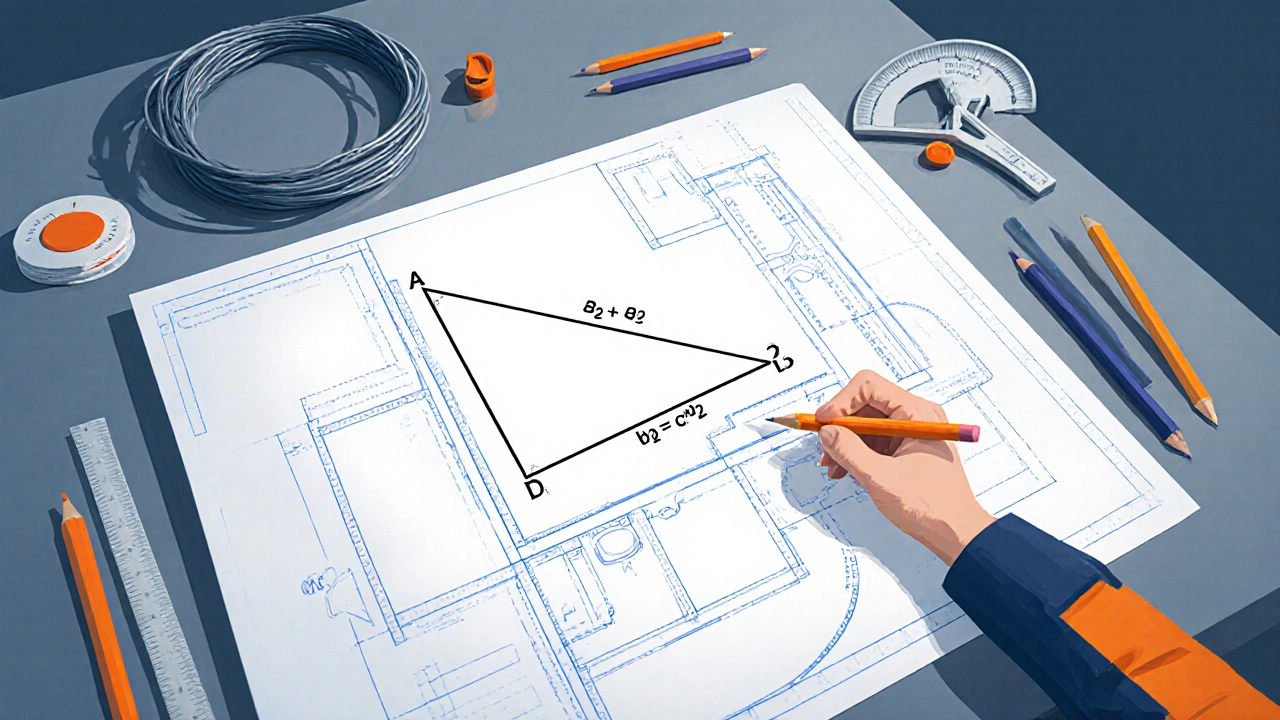Math Skills Every Electrician Needs

Ohm's Law & Wire Size Calculator
Electrical Calculator
Calculate voltage, current, resistance, voltage drop, and recommended wire size for your electrical circuits.
Results
When you step onto a job site, a Electrician is a tradesperson who installs, maintains, and repairs electrical systems in homes, businesses, and industrial settings relies heavily on math to keep lights on and machines humming. But you don’t need a Ph.D. in calculus-just a solid grasp of a few core concepts. Below you’ll find exactly which math topics show up every day, how they’re used, and practical ways to master them before you even pick up a wire stripper.
Key Takeaways
- Basic algebra, geometry, and trigonometry cover 90% of the calculations electricians perform.
- Ohm’s Law and power formulas turn raw numbers into safe, code‑compliant designs.
- Understanding wire‑size charts (AWG) and conduit fill rules prevents costly re‑work.
- Quick‑reference cheat sheets save time on site and boost confidence.
- Focused practice with real‑world problems beats generic textbook drills.
Core Math Topics You’ll Use Daily
Algebra: Solving for the Unknown
Algebra is the workhorse for any electrician. Whether you’re figuring out the required amperage for a new circuit or adjusting voltage drop, the basic form of an equation-unknown = known values-is the same. For example, to size a breaker you’ll rearrange the formula I = P / V (current = power ÷ voltage) to solve for the missing variable. This is pure Algebra in action.
Geometry: Measuring Space and Angles
Geometry shows up when you plan conduit runs, calculate ceiling heights, or determine the area of a room for lighting layout. The Pythagorean theorem (a² + b² = c²) helps you estimate the length of a wire that must travel around corners without actually measuring every foot. Knowing how to compute areas and perimeters also informs how many fixtures you need to meet illumination standards.
Trigonometry: Working with Angles and Waves
When you deal with three‑phase power or calculate voltage drop over long runs, Trigonometry becomes useful. Sine, cosine, and tangent let you resolve vector quantities-like breaking down a 120‑degree phase shift into usable components. In practice, a quick “cosθ” lookup can tell you how much voltage is lost over a specific angle of a transformer winding.
Ohm’s Law: The Electrical Math Foundation
Ohm’s Law (V = I × R) is the baseline formula for every electrician. It ties voltage (V), current (I), and resistance (R) together, letting you solve for any one variable when the other two are known. Whether you’re checking a motor’s start-up current or ensuring a circuit won’t exceed a breaker’s rating, you’ll be rewiring this equation over and over.
Power Calculations: Watts, Volt‑Amps, and Efficiency
Power formulas (P = V × I for real power, VA = V × I for apparent power) let you size transformers, UPS units, and panel boards. Understanding the difference between watts (real power) and volt‑amps (apparent power) is crucial when you’re designing circuits that support heavy loads like air‑conditioners or industrial machinery.
Wire‑Size Selection: American Wire Gauge (AWG)
Choosing the right wire gauge prevents overheating and voltage drop. The American Wire Gauge (AWG) chart links gauge numbers to ampacity limits. You’ll cross‑reference the calculated current from your algebraic equations with the AWG table to pick a safe wire size.

How Each Math Topic Applies on the Job
Below is a quick look at typical tasks and the math behind them.
| Math Topic | Common Task | Key Formula / Concept |
|---|---|---|
| Algebra | Sizing a breaker for a new appliance | I = P / V |
| Geometry | Planning conduit length around corners | Pythagorean theorem |
| Trigonometry | Analyzing three‑phase voltage vectors | V_phase = V_line × sin(θ) |
| Ohm’s Law | Checking voltage drop on a feeder line | V_drop = I × R |
| Power Calculations | Choosing a UPS rating | P = V × I |
| AWG Charts | Selecting wire gauge for a 30A circuit | Match ampacity to gauge |
Study Tips and Resources for Mastering Electrical Math
1. Practice with real‑world problems. Grab a residential wiring textbook and redo every calculation on a sample house plan. The more you apply the formulas, the more instinctive they become.
2. Use flashcards for key constants-like 120V for standard outlets or 240V for dryers. Memorizing these speeds up the algebra steps.
3. Leverage free online calculators for voltage drop and conduit fill, but always verify the result by hand. This builds confidence that the tool isn’t a crutch.
4. Join a local trade school or apprenticeship program that includes a math component. In‑person instruction lets you ask "what‑if" questions that textbooks rarely cover.
5. Subscribe to industry newsletters (e.g., Electrical Contractor Magazine) that publish case studies with the exact math you’ll need on a daily basis.

Quick Reference Cheat Sheet
- Ohm’s Law: V = I × R; I = V / R; R = V / I
- Power: P (watts) = V × I; VA (volt‑amps) = V × I (for reactive loads)
- Voltage Drop (approx): V_drop ≈ 2 × K × I × L / CM
- Conduit Fill: Keep fill ≤ 40% for more than two conductors
- Wire Gauge: Use AWG chart; 14AWG = 15A, 12AWG = 20A, 10AWG = 30A
Frequently Asked Questions
Do electricians need to know calculus?
Most on‑the‑job calculations stop at algebra, geometry, and a bit of trigonometry. Calculus is useful for specialized fields like power‑system engineering but isn’t required for typical residential or commercial work.
How much time should I spend on math before an apprenticeship?
Aim for at least 20‑30 hours of focused practice covering the core formulas. Run through at least three full house‑wiring scenarios to cement the concepts.
Can I rely solely on smartphone calculators?
Calculators are great for speed, but you must understand the input and output. A mis‑typed unit or wrong formula can lead to unsafe installations, so always double‑check by hand.
What’s the biggest math mistake new electricians make?
Skipping the voltage‑drop calculation on long runs. It looks small on paper but can cause lights to flicker or motors to overheat.
Where can I find free practice problems?
Many trade‑school websites publish sample worksheets. The National Electrical Code (NEC) also includes example calculations in its annexes.

Post-Comment